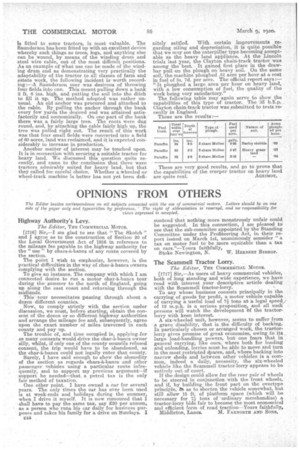OPINIONS FROM OTHERS
Page 24

If you've noticed an error in this article please click here to report it so we can fix it.
The Editor invites correspondence on all subjects connected with the use of commercial motors. Letters should be on one side of the paper only and typewritten by preference. The right of abbreviation is reserved, and noresponsibility for views expressed is accepted.
Highway Authority's Levy.
The Editor, THE COMMERCIAL MOTOR.
[1716] Sia—I ant glad to see that " The Skotch " and I agree as to the construction of Section 20 of the Local Government Act of 1916 in reference to the mileage fee payable to the highway authority for the " use " by chars-A-banes of any route covered by the section.
The point I wish to emphasize, however, is the practical difficulties in the way of char-h.-bancs owners complying with the section.
To give an instance. The company with which I am connected desire to run a motor ohar-a-bancs tour during the summer to the north of England, going up along the east coast and returning through the midlands.
This -tour necessitates tpassing through about a dozen different counties.
Now, to comply strictly with the section under discussion, we must, before starting, obtain the consent of the dozen or so different highway authorities and arrange the mileage fee and, subsequently, agree upon the exact number of miles traversed in each county and pay up. The trouble of, and time occupied in, applying.for so many consents would drive the ohar-a-bancs owner silly, whilst, if only one of the county couneils refused consent, the trip would have to be abandoned, as the char-h-bancs could not legally enter that county. Surely, I have said enough to show the absurdity of the section as regards chars-a-banes and other passenger vehicles using a particular route infrequently, and to support my previous argument—if support be needed—that a petrol tax is the only fair method of taxation.
One other point. I have owned a car for several years. The only times the car has ever been used is at week-ends and holidays during the summer, when I drive it myself. It is now rumoured that I shall have to pay the same tax, say £20 per annum, as a person who runs his car daily for business purposes and takes his family for a drive on Bundays. I 014
contend that nothing more monstrously unfair could be suggested. In this connection, I am pleased to see that the sub-comrnitee appointed by the Standing Committee under the Profiteering Act, in their report issued on March 1st, unanimously. consider " a tax on motor fuel to be more equitable than a tax on cars."—Yours faithfully, Stoke Newington, N. W. HERBERT BIBHOP.
The Scammell Tractor Lorry.
The Editor, THE COMMERCIAL MOTOR.
[1717] Sir,—As users of heavy commercial vehicles, both of long standing and wide experience, we have read with interest your descriptive article dealing with the Scammell tractor-lorry.
To any whose business consists principally in the carrying of goods for profit, a motor vehicle capable of carrying a useful load of 71 tans at a legal speed/ of 12 m.p.h. is a serious proposition4 and all such persons will watch the development ()f the tractorlorry with keen interest.
A six-wheeled unit, hosvever, seems to suffer from a grave disability, that is the difficulty of backing. In particularly chosen or arranged work, the tractorlorry gives promise of great economies, owing to its large load-handling powers, but one fears that in general carrying, like ours, where both for loading and unloading, lorries must be able to move and turn in the most restricted Owes, and, where backing into narrow shells and between other vehicles is a common, indeed a daily, necessity, the six-wheeled vehicle like the Scammell tractor-lorry appears to be entirely out of court. If the design could allow for the rear pair of wheels to be steered in conjunction with the front wheels, arid if, by building the front part on the overtype
principle, as to shorten the vehicle somewhat, but still allow 15 ft. of platform apace (which will be necessary for 71 tons of 'ordinary merchandise) a tractor-lorry bids fair to become the most economical and efficient form of road traction—Yours faithfully,
Middleton, Lancs. M. FARNORTH AND SONS.


























